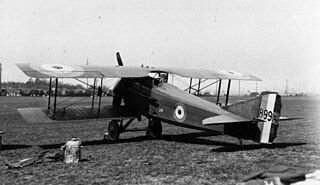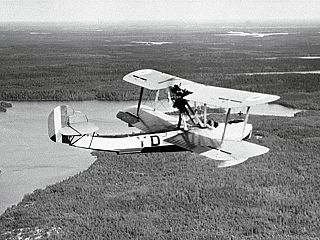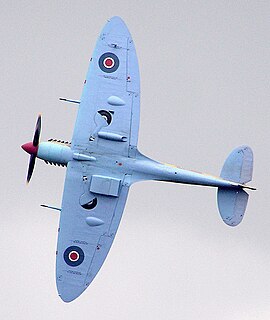Aircraft

| Model name | First flight | Number built | Type |
|---|---|---|---|
| Early Bird Spad 13 | at least one | Replica First World War fighter | |
| Early Bird Jenny | 24 | Replica First World War trainer | |
| Type | Privately held company |
|---|---|
| Industry | Aerospace |
| Fate | Out of business |
| Headquarters | , |
| Products | Kit aircraft, aircraft plans |
The Early Bird Aircraft Company was an American aircraft manufacturer based in Erie, Colorado. The company specialized in the design and manufacture of historical replica aircraft, sold as both kits or as just printed plans for amateur construction. The company's designs were marketed for a time by Leading Edge Air Foils. [1] [2]
The company produced two designs. The Early Bird Spad 13 is an 80% scale replica of the First World War SPAD S.XIII fighter. The Early Bird Jenny is a 67% scale replica of the First World War Curtiss JN-4 Jenny trainer. Both aircraft are constructed from a mix of steel and aluminum tubing, with some wooden parts and with flying surfaces covered in doped aircraft fabric. [1]

| Model name | First flight | Number built | Type |
|---|---|---|---|
| Early Bird Spad 13 | at least one | Replica First World War fighter | |
| Early Bird Jenny | 24 | Replica First World War trainer | |

The Curtiss JN "Jenny" was a series of biplanes built by the Curtiss Aeroplane Company of Hammondsport, New York, later the Curtiss Aeroplane and Motor Company. Although the Curtiss JN series was originally produced as a training aircraft for the US Army, the "Jenny" continued after World War I as a civil aircraft, as it became the "backbone of American postwar [civil] aviation".

The SPAD S.XIII is a French biplane fighter aircraft of the First World War, developed by Société Pour L'Aviation et ses Dérivés (SPAD) from the earlier and highly successful SPAD S.VII.

SPAD was a French aircraft manufacturer active between 1911 and 1921. Its SPAD S.XIII biplane was the most produced French fighter airplane of the First World War.

The SPAD S.VII was the first of a series of highly successful biplane fighter aircraft produced by Société Pour L'Aviation et ses Dérivés (SPAD) during the First World War. Like its successors, the S.VII was renowned as a sturdy and rugged aircraft with good climbing and diving characteristics. It was also a stable gun platform, although pilots used to the more manoeuvrable Nieuport fighters found it heavy on the controls. It was flown by a number of the famous aces, such as France's Georges Guynemer, Italy's Francesco Baracca and Australia's Alexander Pentland.

In aviation, the term tractor configuration refers to an aircraft constructed in the standard configuration with its engine mounted with the propeller in front of it so that the aircraft is "pulled" through the air. Oppositely, the pusher configuration places the airscrew behind and propels the aircraft forward. Through common usage, the word "propeller" has come to mean any airscrew, whether it actually propels or pulls the plane.

San Diego Air & Space Museum is an aviation and space exploration museum in San Diego, California, United States. The museum is located in Balboa Park and is housed in the former Ford Building, which is listed on the US National Register of Historic Places. SDASM was established by articles of incorporation on October 12, 1961 and opened to the public on February 15, 1963.

The Nieuport 28 C.1, a French biplane fighter aircraft flown during World War I, was built by Nieuport and designed by Gustave Delage. Owing its lineage to the successful line of sesquiplane fighters that included the Nieuport 17, the Nieuport 28 continued a similar design philosophy of a lightweight and highly maneuverable aircraft.

The Canadian Vickers Vedette was the first aircraft designed and built in Canada to meet a specification for Canadian conditions. It was a single-engine biplane flying boat purchased to meet a Royal Canadian Air Force (RCAF) demand for a smaller aircraft than the Vickers Viking with a much greater rate of climb, to be suitable for forestry survey and fire protection work. The type went on to have a long and distinguished career in civil operations in Canada. Most of the topographical maps in use in Canada today are based on photos taken from these aircraft.

The Wright Model B was an early pusher biplane designed by the Wright brothers in the United States in 1910. It was the first of their designs to be built in quantity. Unlike the Model A, it featured a true elevator carried at the tail rather than at the front. It was the last Wright model to have an open-frame tail. The Model B was a dedicated two-seater with the pilot and a passenger sitting side by side on the leading edge of the lower wing.

The SPAD S.A was a French two-seat tractor biplane first flown in 1915. It was used by France and Russia in the early stages of the First World War in the fighter and reconnaissance roles. It was a unique aircraft that carried its observer in a nacelle ahead of both wing and engine.

The wing configuration of a fixed-wing aircraft is its arrangement of lifting and related surfaces.

Slats are aerodynamic surfaces on the leading edge of the wings of fixed-wing aircraft which, when deployed, allow the wing to operate at a higher angle of attack. A higher coefficient of lift is produced as a result of angle of attack and speed, so by deploying slats an aircraft can fly at slower speeds, or take off and land in shorter distances. They are usually used while landing or performing maneuvers which take the aircraft close to a stall, but are usually retracted in normal flight to minimize drag. They decrease stall speed.
Airdrome Aeroplanes is an American aircraft manufacturer, founded by Robert Baslee, that offers a large selection of kit aircraft for amateur construction. The company is based in Holden, Missouri.

War Aircraft Replicas International, Inc. is an American aircraft manufacturer, originally located in Brandon, Florida and now Tulsa, Oklahoma, that specializes in kit built replica aircraft of World War II fighters.
The Circa Reproductions Nieuports are a family of Canadian 7/8 scale World War I sesquiplane aircraft replicas designed by Graham Lee of Lamont, Alberta for amateur construction from plans sold by Lee's company Circa Reproductions. Leading Edge Air Foils of Peyton, Colorado at one time also made construction kits available. Lee's Nieuports were among the earliest First World War replicas available and paved the way for later companies to produce plans and kits for a great variety of warbirds.
The Loehle SPAD XIII is an American single-seat ultralight aircraft scale replica of the First World War SPAD XIII fighter produced in kit form by Loehle Aircraft for amateur construction.
The Early Bird Spad 13 is an American homebuilt aircraft that was designed and produced by the Early Bird Aircraft Company of Erie, Colorado. When it was available the aircraft was supplied as a kit and also in the form of plans for amateur construction.

The Early Bird Jenny is an American homebuilt aircraft that was designed by Dennis Wiley and produced by the Early Bird Aircraft Company of Erie, Colorado, also by Leading Edge Airfoils of Peyton, Colorado. When it was available the aircraft was supplied as a kit and also in the form of plans for amateur construction.

Leading Edge Air Foils LLC, usually called LEAF, is an American aircraft parts supplier based in Lyons, Wisconsin. It is a US limited liability company.

The Wag-Aero Group is an American aircraft manufacturer that was founded by Dick and Bobbie Wagner in the 1960s and is based in Lyons, Wisconsin. The company specializes in the design and manufacture of kit aircraft and aircraft parts for amateur construction.